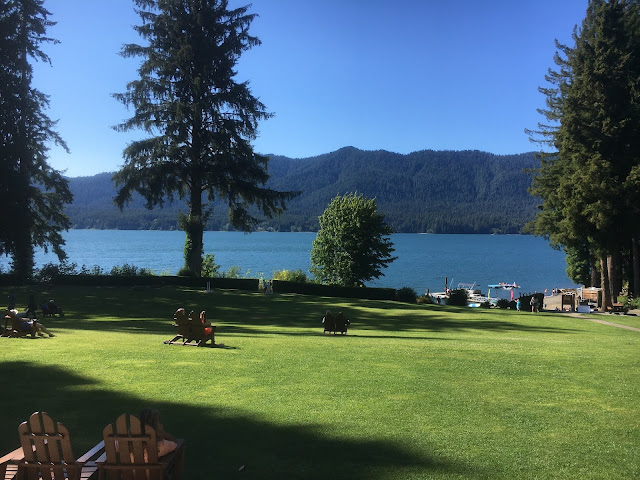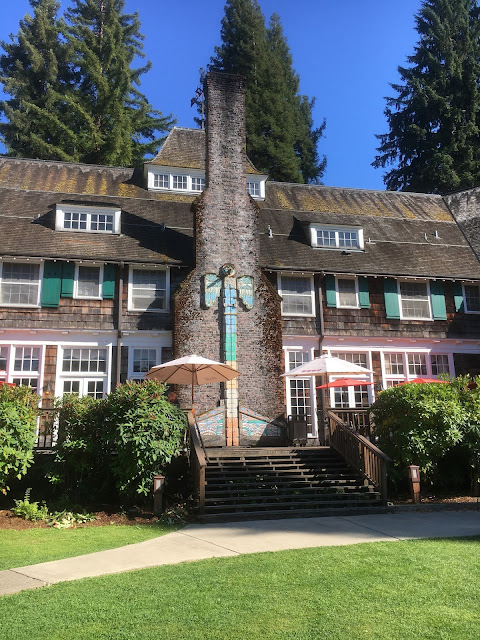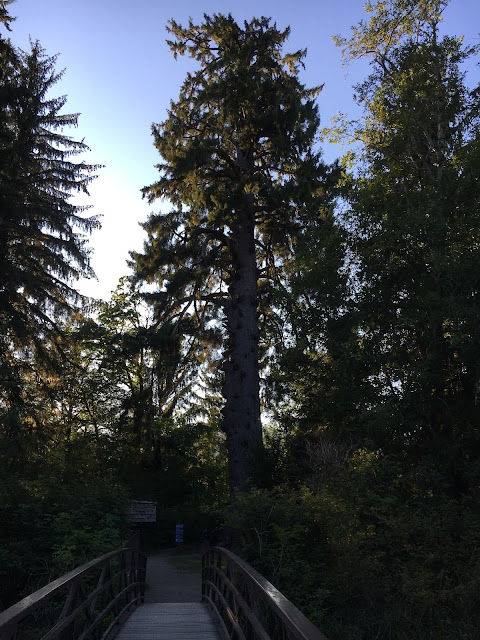In March 2021, visiting Olympic National Park seemed to be a pipe dream. What if we took a two-week vacation, spending five days in Olympic National Park, another three days in Seattle, four days in Sunriver, Oregon, and the last two in Portland, Oregon? The trip seemed ambitious for sure, but my deep-seated desire to see the Pacific Northwest made the dream a reality.
After a six hour plane ride across the country, we flew into Portland, OR, picked up a rental vehicle and drove a leisurely three hours Northwest toward Olympic National Forest and Lake Quinault Lodge. A part of me wanted to take a side adventure to see some of Oregon's rugged coastline, particularly Cannon Beach, but after a long day of traveling, I was outvoted by the two Lews to just "head to our hotel."
I didn't object. Our hotel, after all, would be Lake Quinault Lodge, one of the two places we would stay while visiting Olympic National Park. For anyone who hasn't heard of Olympic National Park, particularly my friends and neighbors back East, you're not alone. While it is one of the ten most visited National Parks with approximately 3 million visitors annually, it doesn't have quite the same notoriety as Yellowstone, the Grand Canyon, or Yosemite. My son asked me naively, "So what makes Olympic National Park special?"
At the beginning of the trip, I wasn't sure how to answer him. Without seeing any of the sights for myself, do I tell him its the glacier-capped peaks of the Olympic Mountains; the 60 miles of rugged and picturesque shoreline, which is the longest wilderness coastline in the United States; the twelve major rivers and approximately 200 streams fed from the run-off of glaciers; or its old-growth and temperate rainforests that boasts a biodiversity of animals found nowhere else in the world? (For example, according to a book I purchased called Lake Quinault Lodge: Washington's Olympic National Forest published by Smith-Western Co., "There are 18 animals in the park found nowhere else in the world. The signature banana slug, native to the Northwest, lives in the rain forest as do the northern spotted owl, the marbled murrelet, jumping mouse, shrew and Douglas squirrel.")
As we pulled up to Lake Quinault Lodge, we already knew this National Park trip would be a trip like no other. Two to three-hundred foot trees stood at our feet, and the Lodge was situated right by Lake Quinault, a beautiful crystal blue lake fed by glacier water from the Quinault River ("a 33-mile long river, home to some of the greatest salmon and steelhead fishing in the world").
On our first full day at Lake Quinault Lodge, we treated ourselves to a hearty breakfast and prepared to hike the Gatton Creek Trail and the Quinault Rain Forest Nature Trail. It was during breakfast that we learned President Franklin D. Roosevelt stayed here in the 1930's (and sat in the same dining room) during his first research trip to create Olympic National Park. (He later designated it a National Park in 1938 "to protect the wildest and most beautiful part of the [Olympic] peninsula.")
Another interesting fact is that Lake Quinault Lodge (constructed completely of timber) was built in 1925 and designed by architect Robert Reamer, the designer of the Old Faithful Inn at Yellowstone National Park. (I always enjoy learning about the history of a place, and it was fun to connect the dots between this lodge and the one at Old Faithful.)
The five-mile loop we walked the first day was our longest hike on the trip, and yet it was the perfect introduction to the world of an old-growth, Pacific Northwest Rainforest. We marveled at the large, moss-covered trees, not knowing that there would be even larger and greener forest to be discovered the next day near Lake Crescent and the Hoh Rainforest. (The 60-70 degree weather was another perfect touch; in fact, summer days in Olympic National Park are usually dry and 70 degrees.)
In the evening, we ate a delicious meal on the main deck and rested knowing we would be going on a full-day bus tour in the morning. We probably could have benefited from an additional night's stay at Lake Quinault Lodge, but we did experience a lot during our two night visit.
Other attractions included the Lake Quinault Museum, a kitschy museum of artifacts and memorabilia collected from the residents of the Lake Quinault area--this included Native American artifacts such as dugout canoes and basketry; it also featured rooms and items, showing logging/pioneering life. (I could have easily spent a full-hour in the museum rather than the 35 minute sprint I took before closing.)
The other "attractions" are the World's Largest Sitka Spruce Tree, located a short walk away from the lodge. (It's estimated to be over 1,000 years-old!) And, the human-sized Sasquatch or Bigfoot stuffed animal that guards the doors of the lodge (and is incidentally sporting a COVID mask these days). Right next to him is a glass-case listing recent sightings of Bigfoot in Washington State according to the Bigfoot Field Researchers Association. I'm glad we didn't bump into him on any of our hikes!!
Again, Lake Quinault Lodge was the perfect "introduction" to all Olympic National Park has to offer. While I was certainly impressed with the beautiful lodge, the rainforest nature trail, and the world's largest Sitka Spruce, I had no idea that more areas of enchantment--on the coast, in the forest, and on the mountaintops--were waiting for us.






















































Can't wait to see more of your trip. I still need to get to Oregon - my last state of 50!
ReplyDeleteOh, that's so cool, Dara! I'm not close to seeing all 50 states yet, but I can tell you that you'll love Oregon!!
Delete